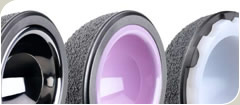Hip Components
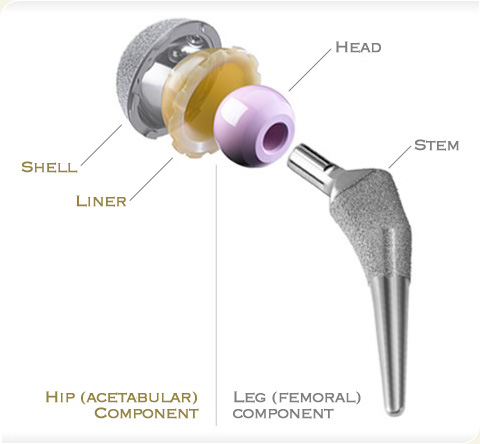
A hip implant (or prosthesis) consists of four components that replicate the hip joint:
- Shell that is fixed to the hip socket.
- Liner fits between the shell and the head.
- Head or ball which articulates with the liner.
- Stem that fixes into the thigh bone (femur)
All components can be engineered from different materials. Your surgeon will recommend components with materials that suit your life-style and help you recover quickly.
Shell
The shell fits into the hip joint socket and needs to be fixed in place. The materials used for the shell are crucial to enable the implant to be fixed to the hip socket effectively. Cobalt chrome or titanium alloys have been the most popular materials.
Porous metal
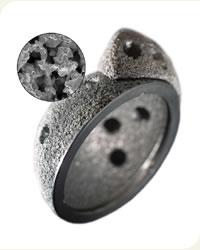
Advances using porous metals have significantly improved the ability of the bone to grow quickly into the outer surface of the shell. The pure titanium or tantalum has pores in the metal that mimic coral which helps the living bone to grow into the coral-like porous metal surface. These two materials are highly bio-compatible, but at the same time they are strong and flexible. They are ideal for revision hip surgery.
Liner
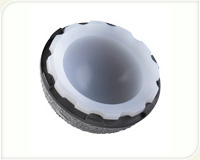
The liner is fixed inside the shell. It acts as a bearing surface for the head (ball) which is attached to the stem. Movement causes friction between the lining and the head. Therefore, the materials that form the lining are crucial to reduce wear to a minimum. The articulating surfaces must be exceptionally smooth but also very hard-wearing.
- Read more about the advances in metal on metal, ceramic on ceramic, ceramic on metal, E-Poly →
The Head
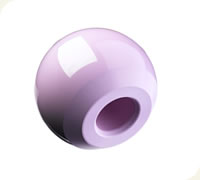
The head (ball) articulates with the liner and can be manufactured from metal or ceramic. The head is inserted on the morse taper at the top of the stem.
- Read more about the advances in metal on metal, ceramic on metal, ceramic on ceramic and big head technology →
Plastic (polyethylene)

Polyethylene liners are resilient and manufactured to be incredibly smooth. However, until recently they were the Achilles heel of the operation. Over time constant friction creates wear particles and debris builds up which sometimes results in bone resorption (osteolysis). However, recent break-throughs in polyethylene technology have diminished this effect, reducing the wear rate significantly, making polyethylene an attractive option for the majority of patients.
E-Poly was a breakthrough technology when it was developed. It is processed below melting temperature and irradiated. Vitamin E (α tocopherol), which is a naturally occurring antioxidant, is infused into the plastic, and stabilises free radicals by donating a hydrogen atom from the –OH groups; free radicals from the plastic are transferred to the vitamin chemical structure. This chemical interaction dramatically reduces the wear rate by up to ten fold when compared with conventional polyethylene. Laboratory trials confirmed the excellent wear properties of E-Poly and it is regularly used for bearing surfaces in hip replacements.
The massive reduction in wear is a giant step forward in controlling one of the most important failure mechanisms in joint replacements and is particularly important in active patients.
- Read more about the break-through in polyethylene →
- Read about polyethylene in the national press →
Stem
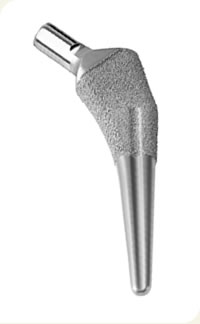
The stem is fixed into the thigh bone (femur) and it is fixed, or held in place, either by using cement or a cementless prosthesis.
A cemented stem is fixed by a type of acrylic cement that acts as a grout, filling the bone marrow space between the metal stem and the bone.
A cementless stem has a fine mesh, beaded or porous surface which abuts against living bone. Bone grows into these uneven depressions on the surface of the implant. Surface coatings such as hydroxyapatite may also be applied to the irregular surface of cementless stems to aid fixation.
Implant Selection
A prosthesis is chosen by the surgeon on a case by case basis. A patient’s specific circumstances are considered in depth. These will include the medical indications or contra-indications, and the lifestyle and age of the patient.

